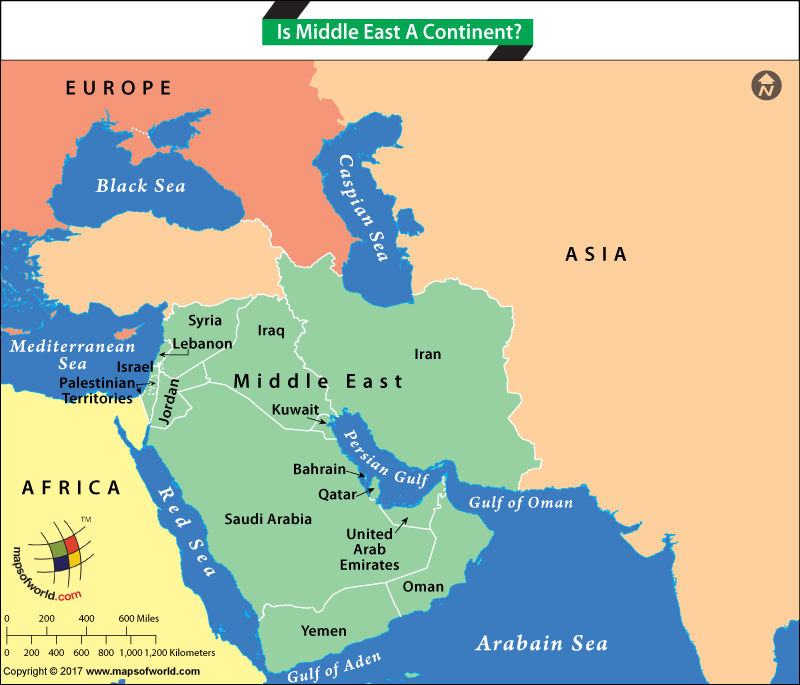Is Middle East a Continent?

The Middle East is a place where major religions like Judaism, Christianity, and Islam started. This makes it very important for religious history and the area has a lot of oil and natural gas, which makes it very significant economically. Its valuable resources play a big role in world politics. In this article we will learn “Is Middle East a Continent?”, “where it is”, and more.
Middle East- A Continent?
The Middle East is not a continent, it is a region that includes countries from Asia and Africa. It lies in the Western Asia but also includes parts of North Africa. This area is known for its unique culture, history, and geopolitical role.
Where is the Middle East?
It is a region in Western Asia with a part of it extending into North Africa. It is just below Eastern Europe and above Africa. The area is surrounded by the Mediterranean Sea on the west, Indian Ocean on the south and Caspian Sea on the north.
History of Middle East
Here’s an overview of its history:
-
Ancient Civilizations
The Middle East is known as the “Cradle of Civilization” because some of the earliest advanced societies originated here. Around 3000 BCE, ancient Mesopotamia, part of modern-day Iraq, saw the rise of cities like Uruk, Ur, and Babylon. Writing was first developed here, with a script known as cuneiform. Additionally, some of the earliest laws were also created here, including the Code of Hammurabi, one of the oldest known sets of written laws.
-
The Rise of Major Religions
Over a long period of time, the Middle East became a place where three major religions originated which were Judaism, Christianity, and Islam. Israel is an important place for the Jews, where king David and king Solomon once ruled. Christianity began spreading from the city of Jerusalem and in the 600s, Islam started on the Arabian Peninsula when Muhammad introduced it and spread a new way of religious and political life beyond Arabia.
-
Islamic Empires
After Muhammad passed away, Islamic rule spread quickly under the leadership of caliphates. Two groups, the Umayyad and Abbasid dynasties, were the most important. They led a golden age where science, medicine, and art flourished. During this time, cities such as Baghdad became important centers for learning and cultural development.
-
Ottoman Empire
By the 1500s, the Empire had grown into a dominant power in the Middle East. it extended its reach into Eastern Europe, Western Asia, and North Africa. Later, the empire declined and disintegrated in the 20th century. Following World War I, European nations redesigned many borders, established new nations and altered the landscape of the region.
-
Modern Era
In the 20th century, the Middle East experienced many changes. The people living there decided to form their own independent countries, the oil reserves were discovered and long term conflict between Arabs and Israelis took action. The oil was a good source of wealth, but it attracted unwanted attention and interference from other countries. Following World War II, Israel’s establishment led to several wars such as the Arab-Israeli war, the Iran-Iraq War and the Gulf Wars.
-
Contemporary Issues
The Middle East is still an important place for global politics, it frequently faces challenges like religious disagreements, terrorism, fights for democracy and conflict of the Syrian civil war. The region has oil supplies which makes it an essential area along with its strategic location which influences the politics on a global level.
Countries in the Middle East
The Middle East includes Saudi Arabia, Iran, Iraq, Syria, Israel, Jordan, Lebanon, Palestine, United Arab Emirates, Qatar, Bahrain, Kuwait, Oman, Yemen, Turkey, and Egypt.
Interesting Facts
- The Middle East has amazing buildings ranging from old ones like the Pyramids of Giza in Egypt to new ones like the Burj Khalifa in Dubai, which is the tallest building in the world.
- The Dead Sea, located between Jordan and Israel, is the lowest point on Earth’s surface on dry land. It’s famous for having a lot of salt in its water, which makes it easy for people to float without trying.
Related Links